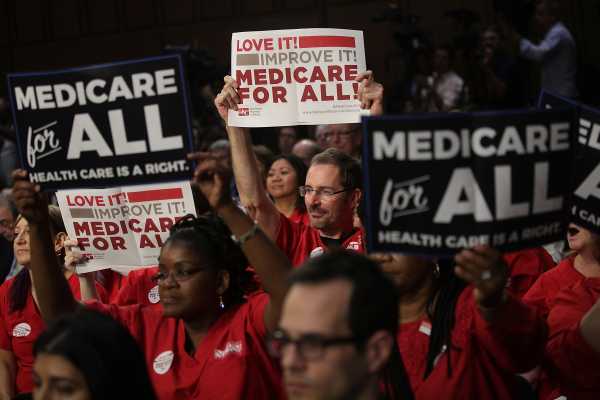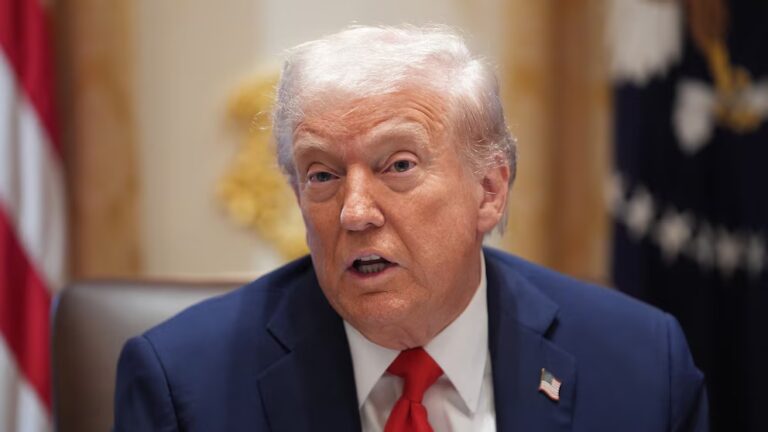
The pile of Medicare-for-all plans just keeps growing. A new contender is Medicare for America, put forth by Reps. Rosa DeLauro (D-CT) and Jan Schakowsky (D-IL). It was heavily informed by the work of Yale professor Jacob Hacker.
I caught up with Hacker, who has been working on and writing about the thorny problem of universal health care for going on 20 years now.
“If you look at other rich countries, their systems work well because they cover everyone basically as a right of citizenship and they exert system-wide control over costs,” Hacker told me during our 40-minute conversation. “Our system has pockets that work that way. Medicare does exert control over its portion of the costs. But a lot of it doesn’t.”
The Medicare for America program also shares a lot of similarities with the Center for American Progress’s Medicare Extra For All plan, one of the eight health care expansion proposals floating around Washington that Sarah Kliff and I surveyed last month.
In very brief, here’s what this plan would do:
- The uninsured, people currently purchasing insurance in the Obamacare marketplaces, and Medicaid beneficiaries would automatically be enrolled in an improved Medicare program
- Employers could continue to offer private insurance, so long as it meets certain federal standards. Companies could also elect to send their workers to the public program and pay a contribution toward their employees’ premiums. Likewise, workers could voluntarily leave their job’s insurance for the new public plan.
- Participants would be required to pay premiums, on a sliding scale based on their income; people with lower incomes would pay no premium at all. Out-of-pocket costs would also be based on income and capped at $3,500 for an individual or $5,000 for a family.
- Doctors would be paid Medicare rates, with an additional increase provided for primary care doctors and mental health services.
Hacker and I talked about Medicare for America and how one begins to put together a Medicare-for-all plan, and I got his thoughts on some of the biggest challenges such a significant health care overhaul would likely face. The interview has been edited for clarity and length.
“Even 15 years ago, there were a lot of people saying we have the best health care in the world and you didn’t want to screw that up by getting government too involved — even though government is heavily involved from day one in health care because the markets are so screwed up,” Hacker said. “But it’s almost impossible to sustain that argument today.”
Dylan Scott
As somebody who’s been working on this for 20 years, what do you think explains the seemingly insatiable appetite for health care reform?
Jacob Hacker
We have a system that is truly distinctive in advanced democracies and distinctively poorly performing. We spend more than other countries. We don’t do a lot better or sometimes we do worse on health outcomes and we don’t cover everyone even after the Affordable Care Act.
The insatiable appetite for reform is driven by the fact that we fall so short of a system most people on the left think would be far preferable, whether it was universal mandated private insurance or Medicare-for-all.
Since Medicare’s passage, the unfulfilled hope has been to universalize health care and to do so in a way that’s affordable. For at least 25 to 30 years, the left has really embraced the idea of a Canadian-style national health insurance system.
National health insurance was the orphan of the New Deal, and people are still trying to get the orphan placed with the family.
Dylan Scott
We are talking about nationalizing the health insurance industry. That idea has moved into the mainstream in a way it hasn’t for many other industries or commodities. What do you think it is about health care or health insurance that has made that palatable to a market-minded country like the United States?
Jacob Hacker
I would say two things. One is the theory of competitive markets really breaks down in health care in ways that smart economists who talk about market failure have recognized and discussed for a long time.
You have huge asymmetries of information between providers and patients. Then you have insurance layered on top of that. People don’t have a strong incentive to economize. They need insurance because health care is too costly for them to finance on their own. It’s like a home. You need a mortgage. You need insurance to buy health care. But once you have insurance, then you have to come up with some other way to restrain costs. Then patients start to face the full cost of their care. There’s been debate about the extent to which those problems necessitate a national health insurance system versus mandated private insurance. But most economists believe you have to do some pretty aggressive things to make the market work.
Then there’s the practice side. If you went back 40 or 50 years, our system didn’t look that subpar compared with other countries. Our costs were higher, yes. We didn’t have programs that covered as many people. But our health statistics were reasonably good; in fact, often better than other rich countries.
But we now have a half-century of experience with a variety of national health care programs in other countries that have produced demonstrably superior outcomes.
Even 15 years ago, there were a lot of people saying we have the best health care in the world and you didn’t want to screw that up by getting government too involved — even though government is heavily involved from day one in health care because the markets are so screwed up. But it’s almost impossible to sustain that argument today.
The cost side of it is also one of the few areas for progressives where they know they could reap pretty large savings by expanding benefits.
If you do this right, not only do you get rid of a lot of human suffering and provide better security, but it’s also probably going to make life better for businesses, who are bearing a lot of the costs now, and for the federal and state governments that are bearing a lot of the costs. If you get US prices closer to the international norm, you’re going to save money while also doing a lot of good. There just aren’t a lot of win-wins like that.
But you can only save a lot of money by confronting powerful interests in the system. So I’m not saying it’s easy. But it’s certainly potentially possible.
Dylan Scott
Why combine the cost and the coverage issue?
Jacob Hacker
The most fundamental reason is it’s very hard to put in place powerful mechanism for cost control if there are a lot of people who are outside the system or in systems that are not governed by that price control. Think about the hardship for the uninsured already in this system because they’re often paying the sticker price in hospitals, when Medicare pays much less and big insurers have negotiated lower prices. If you tried to really ratchet down prices, think of the dislocation that would occur if you didn’t have everyone in the system.
That’s a moral as well as an economic point. It’s easier to do economically and it’s morally necessary to get everyone in before you try to ratchet down costs. But there’s another reason, I think: There isn’t a big constituency for health care cost control. Most Americans think the problem is not that we spend too much overall, but that they themselves spend too much personally. They’re not necessarily in it for lower overall costs. All of the people in the system who benefit from how costly it is want to keep those costs. Progressives have usually seen broadening access as the bigger moral imperative than holding down costs.
I think what’s come out in the last 25 to 30 years is there isn’t a big tension between these two. Medicare, for all its inefficiencies and strange features, is the slowest-growing and most inclusive portion of the health insurance system.
Prices are really fundamental in shaping total spending. There are a lot of things we can do to make care more efficient and coordinated, but at a minimum, we need to restrain health care prices because they are essentially constructed fictions by health care providers trying to maximize their incomes. The constraints on those providers in setting prices at levels that are way above what you see in any other advanced democracy are pretty loose. I don’t think people were thinking that even as recently as the debate over the Clinton health plan. In the 2009-2010 debate, there was a recognition but also a realization that the surest way to kill health care reform was to challenge the pharmaceutical industry and hospitals and providers.
I think that’s going to be the next frontier. But that’s going to be tricky. Doctors and hospitals have become pretty powerful political players, and doctors are overwhelmingly supportive of Democrats. There’s that old adage that every dollar of health care spending is a dollar of somebody’s income, and that makes it challenging.
Dylan Scott
So as someone who’s been constructing and fine-tuning a plan like this for a while now, you have a long list of decisions to make. What are the important decisions you have to make?
Jacob Hacker
If you look at other rich countries, their systems work well because they cover everyone basically as a right of citizenship and they exert systemwide control over costs. Our system has pockets that work that way — Medicare does exert control over its portion of the costs — but a lot of it doesn’t.
The No. 1 thing which I think has been somewhat neglected is a commitment to automatic enrollment for all Americans. There are numerous ways you could do it. But you should start with the idea that everyone is in this system and we’ll figure out how to get people to contribute to that cost. Rather than the system we often have today, which is you have to find the coverage, you have to pay for the coverage, and if you ever stop paying for even a moment, you lose your coverage.
No. 2 is how do you do systemwide cost control. There are many choices. All-payer regulation would be one way. Another would be having some kind of default price, if there’s a breakdown in negotiations between insurers and doctors that they have to accept, like, 150 percent of Medicare.
The best going mechanism we have — one that operates nationally and is uniform in its principles — is Medicare. Medicare seems like the obvious reimbursement heavy to bring into the fight. But you could do that in a number of ways, right?
Note private Medicare Advantage plans pay very close to Medicare rates. The reason is everybody who’s in Medicare is either covered by Medicare or these plans. The plans just go to the doctors and say, look, if you don’t accept our rates, you’re going to have to take Medicare rates, because that’s the only alternative, right? So the doctors get a little bit more than the Medicare rates from the private plans.
Once you get a critical mass of people in, the employment-based plans that remain under Medicare for America will be able to leverage that new system to get some degree of cost control.
No. 3 is you have to be able to finance it. Now, I’m not putting these in order of importance. I once was talking to a seasoned policy expert and he said there are three important things in health care reform: financing, financing, financing.
Health care plans have foundered again and again on the shoals of figuring out where to come up with the money. To me, this is in some ways the biggest argument for a Medicare expansion that isn’t single-payer. Where do you come up with the money if you try to essentially socialize the costs of the most costly medical system in the world? There’s a lot of money going through the employment-based system and other pathways that would suddenly go on the federal ledger.
Bernie Sanders’s own team said their plan would cost about 9 to 10 percent of GDP. I’ve pointed out that the tax increase to fund World War II was about 5 percent. That’s a big number. They’re right that you’re just switching private premiums over into public taxes. But I’m incredulous about the idea that you could actually implement that kind of new tax financing as quickly as would be needed to have a universal Medicare system.
But even if you do a different Medicare expansion, you’ve got financing challenges because you wouldn’t want employers or individuals to pay the full cost of the coverage for two reasons: politics and economics. Politics, there’s going to be a huge backlash. Economics, you want employers to find this an attractive option. You want individuals to feel they’re getting a good deal. So in the Medicare for America plan, employers pay 8 percent of payroll, which is below what most of them would pay for comparable health insurance.
Dylan Scott
How does Medicare for America answer some of these questions?
Jacob Hacker
It says right up front it’s going to create a system of automatic enrollment. Every employer is required to either cover their workers or contribute to the cost of coverage. The idea is just like you get signed up for Social Security, you make contributions through payroll taxes, [and] employers will be ensuring you’re enrolled.
On systemwide payments, it’s very clear that Medicare payment rates will be what’s used for people enrolled in this new plan. It does preserve Medicare Advantage, with some modifications, but Medicare Advantage plans tend to pay close to Medicare rates. It essentially says the Medicare payment modalities are going to be adapted to this new population because there are some services that Medicare doesn’t provide now that would have to be provided to younger Americans. One of the nice things is it says there will be a shift toward higher reimbursement rates for primary care and pediatric care as opposed to specialist care.
Then the third thing is financing. The Sanders legislation and some of the others say we’ll figure it out. The truth is that’s how lawmaking happens. There are a lot of Democrats who are legitimately arguing, if Republicans can go pass unfunded tax cuts, why are we so worried about dotting every i and crossing every t of our funding plans for new programs. That said, Nancy Pelosi certainly believes pay-as-you-go is the way to proceed, and I personally believe while you might want to have a transition period where you’re deficit-financing, you have to have a sustainable system that is financed in ways that are transparent.
In Medicare for America, the primary source of financing is the redirection of existing funds. So if Medicaid beneficiaries are moving into this new Medicare plan, then you need to have those state contributions that would have been made to cover Medicaid go into the federal plan. It also has an income tax surcharge and some “sin taxes” — a soda tax, for example. It also has the payroll tax employers are making. Finally, there are premiums paid by individuals. As in Medicare Part B, where older and disabled Americans pay about 25 percent through premiums, there would be premiums as well that cover a portion of it.
Getting up and running isn’t the biggest challenge; the biggest challenge is having sustainable, long-term financing, and there, having a system for keeping prices in check really helps. More people in Medicare means better capacity to control prices.
Dylan Scott
What do you think about disruption and choice? These plans would significantly remake the American health care system, and prior health plans have failed over public fears, sown by the health care industry, that people would lose their health insurance. Obama had to make his “keep your plan” promise when passing the ACA, which mildly backfired once the law started to take effect. There seems likely to be some difficulties getting the public onboard with a plan like this.
Jacob Hacker
One of the primary reasons to move to a system in which employers can continue to provide coverage but if they don’t, you have automatic coverage through a Medicare-like plan, is it minimizes the disruption that occurs. I think it’s worth noting, too, that Medicare beneficiaries themselves are also worried about disruption. A big and successful attack on the Affordable Care Act by Republicans was that Medicare beneficiaries were going to have their coverage disrupted.
I think it makes sense to go slowly in moving people into Medicare to minimize backlash among those who depend on it already. Disruption is one of the big reasons why an immediate move to a single-payer system is probably a bridge too far in American politics for the foreseeable future.
On the point of choice, and indeed, I would preserve the Medicare Advantage option as well as the ability of employers to continue to provide private insurance and in some cases provide multiple plans.
However, I think the choice that matters to people more is the choice of doctor and hospital, and that’s something that’s really under siege in the current system. The work on surprise medical bills really drives home how many people end up spending a lot of money because they go to a hospital and they discover while they maybe have coverage for the hospital’s surgical fee, they didn’t have coverage for the specific doctor that was sewing them up. I think knowing [that] every doctor and hospital in the country is accepting payment if you’re in a Medicare-like plan would be very valuable to people.
The final thing I would say is what behavioral economics has taught us is people don’t really need a lot of choices — they need meaningful choices. The goal would be to think about how to maximize meaningful choices. It would be really important to improve the Medicare Advantage program over time so people are choosing it because they’re really providing more value.
This story appears in VoxCare, a newsletter from Vox on the latest twists and turns in America’s health care debate. Sign up to get VoxCare in your inbox along with more health care stats and news.
vox-mark
VoxCare
Subscribe
By signing up, you agree to our Privacy Policy and European users agree to the data transfer policy.
For more newsletters, check out our newsletters page.
Join the conversation
Are you interested in more discussions around health care policy? Join our Facebook community for conversation and updates.
Sourse: vox.com






